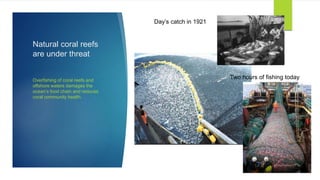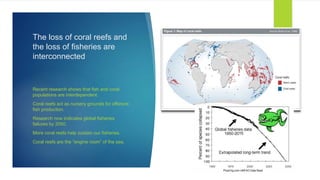FizzyTransition - Building a nursery for coral
- 1. Accelerating the transition to a sustainable planet
- 2. ECO-REEFS
- 3. Coral Reef Systems Coral reefs are the most biodiverse ecosystems on Earth. Coral reefs are home to 25% of all marine life. Coral reefs support more than 200 million people. Coral reefs generate billions of dollars through tourism. About half of the world’s coral reefs have been damaged or destroyed. Coral reefs are the most endangered habitat on the planet.
- 4. ECO-Reefs We design and build super-diversity coral reef ecosystems on existing man-made structures. ECO-Reefs help restore the environment. ECO-Reefs support eco-tourism. ECO-Reefs assist business and local communities.
- 5. Natural coral reefs are under threat Overfishing of coral reefs and offshore waters damages the ocean’s food chain and reduces coral community health. Day’s catch in 1921 Two hours of fishing today
- 6. Natural coral reefs are under threat Global warming and coral bleaching are accelerating the loss of shallow water corals. In 2016, an estimated one third of the shallow water corals on the Great Barrier Reef perished as the result of bleaching. That figure is now closer to 50%.
- 7. The loss of coral reefs and the loss of fisheries are interconnected Recent research shows that fish and coral populations are interdependent. Coral reefs act as nursery grounds for offshore fish production. Research now indicates global fisheries failures by 2050. More coral reefs help sustain our fisheries. Coral reefs are the “engine room” of the sea. PhysOrg.com UNFAO Data Base
- 8. Early attempts to build artificial reefs were unsuccessful The earliest artificial reefs were little more than an excuse to get rid of our garbage. Dumping cars, building materials, ships, and tires were claimed to improve the environment. They failed to attract marine life and often polluted the sea. Many early artificial reef systems are now being removed. Others are banned in some countries.
- 9. Contemporary artificial reefs are largely unsuccessful Many don’t recognize the physical needs of marine life in the coral reef ecosystem. They don’t create a food web to support the fish community. They are wasteful with materials and have a huge carbon footprint. They have a short lifespan because of materials used. They are often designed to suit the builder’s ego rather than meet desired outcomes. Soft bottom structures by Ahmad Ali, UTM, Malaysia
- 10. A background in environmental research and development Site Survey and Evaluation We developed the first remote underwater survey system for Australia. We have surveyed over 1000km of the Great Barrier Reef using divers. Our Chief Scientist developed the first measure of ‘ecological tipping point’. Research and Development Artificial reef shapes, surfaces, and chemistry. Coral propagation techniques for nurseries and reef transplants. Coral farming research with the Department of Fisheries, Malaysia. Training in Sustainability Each year we train university interns in coral culture and environmental sustainability at our Malaysia coral nursery. This university group is from Mexico.
- 11. Backgrounds in oil and gas platform engineering, alternative energy systems, and manufacturing technology Engineering Transport and logistics Oil & gas “brownfield” engineering Offshore structural integrity assessment Production technology Reservoir engineering Shipping and marine operations. Materials management.
- 12. Offshore assets can be repurposed with ECO- Reefs ECO-Reefs can form the basis of new commercial or sport fisheries. ECO-Reefs can create new and exciting scuba diving destinations. ECO-Reefs can create multi-activity attractions for tourist facilities. Repurposing platforms with ECO-Reefs saves decommissioning expenditure and makes environmental sense.
- 13. Offshore assets can be repurposed for fisheries with ECO-Reefs Fisheries production: We have a range of result-specific designs to suit oil and gas platforms. Designs can be biased to suit demersal or pelagic species. Offshore assets can become single reef structures or form the hub of a vast “fish ranching” enterprise. Artist’s impression of platform suspension ECO-Reef modules for large demersal species Calculated biomass distribution based Gulf of Mexico species for 200m oil and gas jacket.
- 14. Offshore assets can be repurposed for tourism with ECO-Reefs Tourism: Designs use proprietary surfaces to create high biodiversity. We can design exciting ‘swim-throughs’, cave, and ‘shaft’ dives that will keep bringing guests back for more. Surfaces are “quick started” and can be up and running in 5 years or less. Artist’s impression of a platform based tourism ECO-Reef Proprietary designs copyrighted by Fizzy Transition Ventures
- 15. Offshore assets can be repurposed and “quick started” with ECO-Reefs Our studies show that surfaces can be “quick started” and that corals can be easily transplanted to ECO-Reefs. We know that species selection and surface chemistry are critical for fast results. Treated surface trials compared to untreated surfaces over a six year period
- 16. Offshore assets can be repurposed for conservation with ECO- Reefs Conservation: Our proprietary super-diversity ECO- Reef will buffer marine life against climate change. Repurposing offshore assets protects endangered coastal species. Building a “Noah’s Ark” for marine life gives back to Nature. Artist’s impression of our proprietary super- diversity blister panel ECO-Reefs quickly become natural reefs Proprietary designs copyrighted by Fizzy Transition Ventures
- 17. Stand alone ECO-Reefs are designed to meet every requirement Designed to meet hydrodynamic forces. Designed to match local species requirements. Designed for fisheries or tourism. Designed to meet the operator’s needs. Designed to last well into the 22nd Century. Our unique “cave and shaft” dive reef Proprietary designs copyrighted by Fizzy Transition Ventures Structure composed of SynCoral, a super-diversity composite.
- 18. Fizzy Transition Ventures follow best environmental practices Best practice eco-engineering aiming for carbon neutrality. Maximized use of recyclable platform materials and natural materials. We achieve maximum biodiversity by integrating micro and macro design. Structures are ecologically and trophically self- supporting. Each structure specifically designed for its physical and biological environment. We focus on the transition from man-made to natural reef ecosystems. Expected appearance of ECO-Reef SynCoral surface after 20 years Slower growing massive corals are replacing faster growing “ quick starter” species
- 19. What will your ECO-Reef look like? The development of a coral reef community depends on the availability of suitable eggs and larvae swept in from other places. Most coral reef species have long-lived planktonic stages and can travel long distances before making the ECO-Reef home. The success of man-made structure depends on surface chemistry and texture as much as shapes and spaces. Fizzy Transition Ventures have solved these problems with Super-diversity ECO-Reefs. We say: “If you build it, they will come… and if they like it, they will stay.” ECO-Reefs offer surfaces and spaces many thousands of times greater than oil and gas jackets for Super-diversity and high population density of marine life.
- 20. Offshore assets have real value and can be repurposed for the future Fisheries and Recreation? Tourism and Diving? Conservation and CSR? Each of these can create new business opportunities for assets already in place on the ocean floor. ECO-Reefs will bring your offshore assets to LIFE again. Make a difference and leave a heritage you can be proud of



















